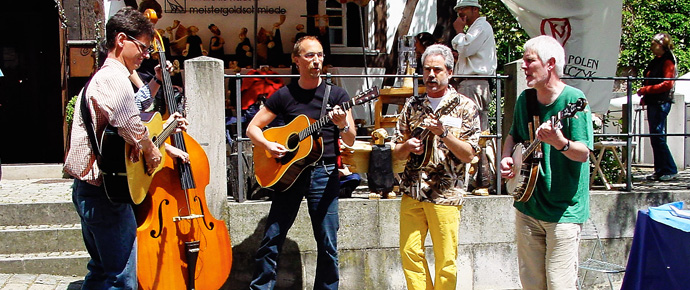
Dirk Brinker on banjo with Backporch Bluegrass
While many musicians suggest that they found their way to bluegrass music quite naturally from an early age, there are some who discover it only by happenstance later in life. That’s often the case with artists that reside overseas and come upon the music as a result of unexpected encounters.
Born in Hagen West Germany, Dirk Brinker claims a disparate list of musical influences. Early on, he listened to classical music, jazz, and pop courtesy of local radio stations and the American Forces Network. However his first encounter with bluegrass came courtesy of watching a banjo player on television one evening while visiting a friend. He thinks it might have been Earl Scruggs.
“I was impressed, and I didn’t forget the drive the music had,” he remembers. “But I had no chance of getting hold of this music. American Forces Network didn’t play it and the German radio stations didn’t either.”
Given that dilemma, Brinker found other more immediate music that attracted his attention. Being a child of the sixties, he was naturally attracted to the Beatles, the Stones, Chuck Berry, and eventually, Cream and Jimi Hendrix. He initially indulged that passion by playing bass and guitar in a local rock band.
Nevertheless, his tastes would change. “With the death of Jimi Hendrix in 1970, I lost interest in electric amplified music,” he says. “I started to listen to Leo Kottke and his 12 string guitar, and became more folk music-orientated in the process. Still, it was really very hard to find that music in our local record stores.”
Brinker’s initial infatuation with bluegrass began in 1973, after he saw the film, Deliverance. “Some weeks later, I bought a banjo,” he recalls. “I was lucky to pick a 5 string. Of course I didn’t know what I needed. It was just the sound of the instrument that appealed to me, more than the tenor banjo. I got the Pete Seeger songbook with it, but that book didn’t work well for me.”
Fortunately, a Scottish acquaintance who also happened to be a banjo player advised him to buy an Earl Scruggs banjo book.
“Thats what I did,” he says. “And then I started practicing. Some years later I found musicians with the same interests and we started a band called Freight Train. In the meantime, I had found some records that I could use for learning, recordings by Flatt & Scruggs, Don Reno, and Bill Monroe.”
Another turning point came when Brinker relocated to Sweden in 1980. He was only there for a year, but it turned out to be a fateful few months. He caught a concert by Tony Trischka and took the opportunity to join one of his workshops.
“He told me that I had to look out for Béla Fleck,” Brinker mentions. “Some months later, Béla Fleck came to Stockholm and I saw him there with the band Spectrum. It was very impressive.”
Meanwhile, Brinker says his band Freight Train was drifting apart, mainly due to the fact that the members lived in different geographic locales. Nevertheless, they reunited in 1983, rechristening themselves as Backporch Stringband. It featured the standard array of instrumentation — mandolin, guitar, double bass, and Brinker on the 5 string banjo.
At the same time, Brinker’s own musical progression was moving forward. “In 1990, I met Béla Fleck at a workshop in Hamburg Germany,” Brinker recalls. “He held it in a cold and damp basement of a bar. Some 25 tenor banjoists were in the bar with another mentor while the 5 string banjoists were in the basement with Béla.”
In the meantime, Backporch Stringband was growing its own efforts as well. “The repertoire was really mixed,” Brinker says. “We played a few traditional bluegrass tunes, but even more pop tunes, which we arranged in a bluegrassy style. I never really like the slow tunes in bluegrass, because they appeared too ‘sweet’ for my tastes. However I’ve always liked Foggy Mountain Breakdown, Dear Old Dixie, Jerusalem Ridge …”
Inevitably, it was the band’s ability to reimagine songs from different and distinct genres — some 140 number in all, Brinker says — and give them a bluegrass veneer which proved the secret to their success. They made the rounds, from bar gigs and birthdays to corporate events and jubilees. “People were happy that we didn’t play as loud as the rock bands,” Brinker insists. “They often liked our repertoire because they sometimes could sing along.”
Then, in 1994, Brinker turned his attention to African percussion. “It became more and more important for me,” he suggests. “I even played in different drumming bands. I believe that my banjo playing improved a lot while I got more and more familiar with the drums. I was able to play rhythmically with more interesting backup patterns.”
With his retirement in 2013, Brinker began to think about what he really wanted to do musically going forward. First, he quit his band, citing displeasure with its selection of songs.
“Then two years later, I decided to form a group that would only play my music,” he recalls. “It encompasses very simple harmonies – often just one chord – but rhythmically it’s very demanding.”
It promises to be a very distinct change in style from what Brinker did before, but his banjo will still play a prominent part in the mix.
“We don’t have any gigs yet,” he admits. “We’re still practicing.”







